#tundra biome plants
Explore tagged Tumblr posts
Text
Tundra biome: one of the largest biomes in the world
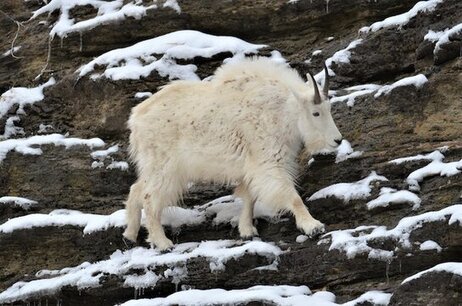

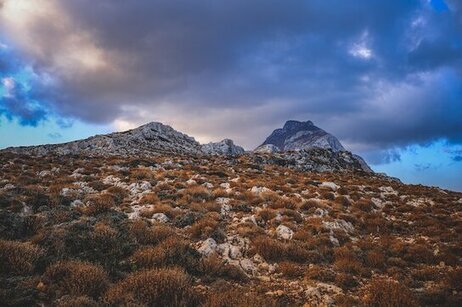
#tundra biome#biome#arctic tundra#alpine tundra#tundra region#tundra ecosystem#arctic tundra biome#alpine tundra biome#tundra biome animals#tundra biome plants#biomes of the world#tundra animals#what is the tundra biome?#Location so tundra biome#types of tundra biome#Environmental conditions of tundra biome#soils of tundra biome#climaet of tundra biome#identify a tundra region
16 notes
·
View notes
Text


COTTON GRASS || low lying / has thin leaves to reduce water loss by transpiration
8 notes
·
View notes
Text
The sadness and agony that emerges everytime I start a new oni save and am forced to remember what it's like to have a dupe without a hat only to put them in a hat because I think they'd look cute only to remember hats make half of them look bald but I spent this long maxing out a skill for them so Im too stubborn to back down and remove the hat
#rat rambles#oni posting#it wouldnt be nearly as much of a problem if dupes didnt all have the same like 3 faces that I suck ass at differenciating at a glance#the amount of times Ive mixed up my maes and nikolas makes me sad Im sorry mae no one should be mistaken with nikola#if I knew how to acess the animation files Id be tempted to make a mod to change it but I dont so Im not#but imagine how cute itd be if abe and nikola had their side spikes stiking out from the sides of their hats#couldnt save the super short haired ppl tho sorry ren ari travaldo turner ruby and probably others too#speaking of my ari I keep mistaking my hassan for ari even tho I dont have an ari yet sorry bestie#hes my main storage and cleaning guy which is the role ari is in my other save#anyways the new save is continuing to go well even if things have slowed down a lil#I managed to get my salt water guiser up and running even if its a very lazy approach of basically just cooling it in a tundra biome#but itll work for the time being until I can get plastic from either drekos or by tapping into my oil biome#Im going for drekos rn since I have a lot of them around but if I can get some atmo suits set up quick enough I might just dive for oil#mainly because I want natural gas for a gas range tbh especially since I started farming waterweed as well#along with duskcaps so I already have access to the ingredients for several high quality gas range foods if I can get one running#now that might be a bit hasty but also I havent actually set base on the teleporter planetoid yet and both the transporters are right there#and I managed to find the sender on my main planetoid so I could pretty easily send over high quality food as a nice start up#this mostly tempts me because theres also a distinct lack of particularly easy to farm plants in the immediate vicinity of the teleporter#which doesnt mean there Wont be food but it does mean that quite a bit of digging will likely need to be done#with is also made tricky by the lack of early settlement oxygen sources available#and while I could theoretically send oxygen from the main colony Id rly rather not until I can get a spom or two set up#which leaves oxyferns and rust as the main oxygen options there until reliable water is found#now one thing I could do is fully transition my main base to getting all its oxygen from a spom and then send the rest of my algae over#my main thing is just Im not rly sure where I wanna put my first spom#I just simply dont have as many options as Id like due to being surrounded by mostly swampy and jungle biomes#not that I couldnt build there or dig them out its just Id rly rather have atmo suits first#which since I am very early in my dreko farm will likely take a lil bit#which also brings up the problem of getting my metal refinery up and running so I dont have to keep using the rock crusher#Ill probably just slap one in one of my tundra biomes as a short term solution but long term Ill probably have to take a shot at a proper#industrial sauna once I get plastic
0 notes
Text
Writing Notes: Habitats
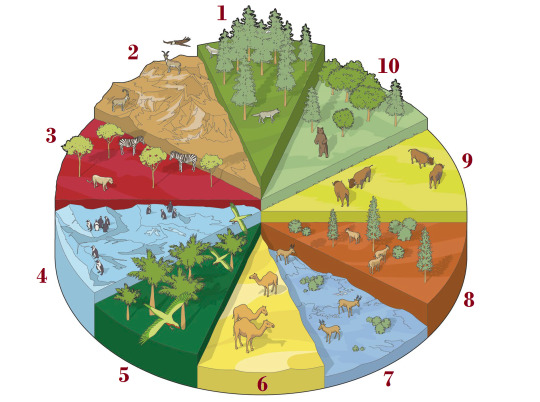
Coniferous forest - Vast areas of Scandinavia, Russia, Alaska, and Canada are the site of coniferous forests—home to moose, beavers, and wolves.
Mountain - High mountain ranges have arctic climates near the peaks, where few plants grow. Animals must cope in dangerous terrain.
Savanna - These tropical grasslands with wet and dry seasons support huge herds of grazing animals and powerful predators.
Polar ice - The ice that forms on cold oceans is a refuge for animals that hunt in the water. The continental ice sheets are almost lifeless.
Tropical rainforest - The evergreen forests that grow near the equator are the richest of all biomes, with a huge diversity of plant and animal life.
Desert - Some deserts are barren rock and sand, but many support a range of plants and animals adapted to survive the dry conditions.
Tundra - These regions on the fringes of polar ice sheets thaw out in summer and attract animals such as reindeer and nesting birds.
Mediterranean - Dry scrub regions, such as around the Mediterranean, are home to a rich insect life and drought-resistant shrubs and plants.
Temperate grassland - The dry, grassy prairies with hot summers and cold winters, support grazing herds such as antelope and bison.
Deciduous forest - In cool, moist regions, many trees grow fast in summer but lose their leaves in winter. The wildlife here changes with the seasons.
Animals, plants, and all living things are adapted to life in their natural surroundings. These environments are called habitats.
Every living species on Earth has its own favored habitat, which it shares with others. These different species interact with each other and with their natural environment—be it hot or cold, wet or dry—to create a web of life called an ecosystem.
Some ecosystems are very small, but others such as rainforests or deserts cover huge areas. These are called biomes.
Life on Land
Different climates create different types of habitats for life on land. Warm, wet places grow lush forests, for example, while hot, dry regions develop deserts. Each biome consists of many smaller habitats and, in many areas, human activity such as farming has completely changed their character.
Source ⚜ More: Writing Notes & References ⚜ Worldbuilding
#writing notes#worldbuilding#writeblr#dark academia#spilled ink#nature#writing reference#literature#writers on tumblr#writing prompt#creative writing#writing ideas#writing inspiration#poets on tumblr#poetry#writing resources
200 notes
·
View notes
Text
More Minecraft ideas, what part of Minecraft needs improvement?
You're wrong, it's ponds.
Ponds, lakes, lava pools. They all suck in Minecraft, they end up just being big holes in the ground with nothing interesting about them that make the landscape ugly and hole ridden
Now you might say “Ivy, literally no one cares” and to that I say, wheesht and accept my ramblings ya donut
So, how do we fix Ponds? It's simply really: make ponds generated structures.
Ponds would now be generated structures taking up one chunk, with an actual human made design to make them, you know, look good. There would be, say, 100 or so different designs to stop them looking to samey (they'd be so small that something like that would be feasible)
Lakes would be done similarly, only with the key difference, they would be made up of 4 chunk “cells”, each making up a corner of the lake.
ponds and lakes in plains or forest biomes would be made of blocks like mud and dirt.
Ponds and lakes in deserts (or oases if you want) would be made up of grass and sand
Ponds and lakes in tundras would be frozen over on the top layer of the water and with clay spawning around the water
Now, let's see some things that can be found in ponds and lakes:
Frogs
Nothing new here, frogs and frogspawn are most common ponds, pond frogs also only come in the green frog varietie.
Perhaps the oasis can have a desert rain frog variant that gives a purple frog light
Toads
Toads and toad spawn can be found in lakes and ponds in forest and plains biomes. Toads emerge from toad spawn in the same way frogs do. Toads have an exaggerated size, being double the size of the frog
Toads come in several colours (Green, Brown, Yellow, Orange and Lime) but these colours do not harbour any game mechanics (in other words: sorry but there are no toadlights)
Toads will eat all mobs with wings, that being the Parrot, Chicken, Phantom, Bat, Bee and the player if they are wearing an elytra, so watch out.
All the aforementioned mobs are scared of Toads, making them and effective deterrent to phantoms in particular
Cattails, Reeds, Rice, Algae and Papyrus
I'll just do all the plant life stuff at once (these will generate dependent on the pond or lake cell)
Algae is a new decorative blocks that can be placed on water
It will connect to other blocks, creating an unbroken surface across the water
Algae has a bright green hue and can be found in both ponds and lakes with the same frequency
Papyrus is a new plant that spawns naturally in the oasis, it is used as a more efficient way of making paper as it can be bonemealed and only one papyrus is needed to make paper
Rice is a plant that grows in water in lakes and ponds spawning in cherry groves.
Rice can be used in two recipes:
Rice Bowls:Putting rice, a bowl and any meat together will craft a rice bowl
This food source that can be eaten twice, eating the meat and then the rice
Sushi: putting rice, dried kelp and one fish into a crafting table creates Sushi, a foodsoarch that can be eaten instantly without playing the eating animation, not very nutritious but good in a pinch

Cattails are a purely decorative plant found in ponds and swamps
Reeds are more common around rivers and lakes, being a fern like plant that grows two tall.
Reeds can be used to craft a new item: Pan Pipes
Combining 3 reeds and 3 string will create pan pipes, these can be played to draw passive mobs towards you so long as the button to play them is held down.
Pan Pipes can also calm neutral mobs like wolves, iron golems and bees, but doing this instantly focus the Pan pipes into cool down
Pan pipes have a cool down double that of the Goat Horn
Bagpipes
By putting Pan Pipes, 3 iron nuggets, 3 red wool and 3 green wool together you can make Bagpipes.
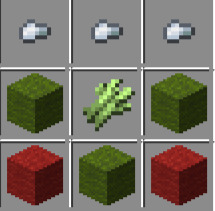
Bagpipes have durability on top of having the same level of cool down as Pan Pipes. Bagpipes cannot be enchanted.
Bagpipes have the ability to PERMANENTLY pacify all hostile mobs in the chunk the player is in.
Bagpipes will break after 10 or so uses
Willow and Palm
Willow and palm are new wood types, Willow spawns around lakes and ponds and Palm spawns around oases.
Willow has a dark Bluish-green colour, complementing mangrove, where as Palm is a desaturated pale white
(These will generate depending on the pond or lake cell)
(Part 1/3)
310 notes
·
View notes
Text


The hamrambes, largest of the lemunkies, arose in the Early Temperocene on the continent of South Ecatoria, descending from a group of large-bodied, short-tailed lemunkies known as the chimpmunks. From these, even bigger species arose that spent more time foraging on the ground, and at sizes of up to 200 kilograms, were too big for much of the native predators such as the lycanines and the tigerillas to tackle.
The coming of the midnight howlers, however, changed up the dynamics in the Middle Temperocene. Predatory lemunkies that had adapted to hunt other arboreal members of the clade, they quickly became quite successful, spreading across the continent across varied biomes, leading to a decline in prey lemunkies who did not adapt fast enough, and pushing the tigerillas to the margins.
As such, the midnight howlers ended up coming into conflict with several different species of the hamrambes: in particular the two extant subspecies of the bearded hamrambe (Pongomimus grandis): the tundra bearded hamrambe (P. g. frigus) which ranges across the cooler coniferous forests south of the continent, and the temperate bearded hamrambe (P. g. sylvus) which ranges further up north. The two subpecies are very similar in size, behavior and social dynamics, both being loosely gregarious foragers that primarily feed on plant matter but occasionally supplement their diets with insects they dig out of bark. However, they differ in the tundra subspecies's adaptations for the cold, such as paler, thicker fur, a bulkier build to better retain heat, and a bigger nasal cavity with an increased complexity of turbinates to warm the cold air entering through as they inhale. Their paw pads on all four limbs are thicker and more insulated, and they have proportionately smaller, rounder ears to reduce heat loss and more hair on their faces to protect against the chilly wind.
Unfortunately for the tundra subspecies, however, the warming climes of the Middle Temperocene have been shrinking their range ever more south, as areas once plagued by harsh winters now grow milder year after year: and allowing the temperate woodland biome to encroach on what was once almost purely conifers and tough shrubs but now beginning to give way to other plants as well. This, in turn, have also encouraged the temperate bearded hamrambes to spread south, eventually overlapping their ranges with their cold-weather cousins. As suitable mates become harder to find in a shrinking habitat, the cross-fertile species begin to intermingle even more, producing fertile hybrids that go on to have young of their own: but gradually diluting the gene pool of the tundra subspecies until eventually, they may be assimilated entirely into the temperate subspecies in the near future: living on in the genes of their kin but disappearing as a purebred phenotype.
-----------
#speculative evolution#speculative biology#speculative zoology#spec evo#hamster's paradise#species profile
66 notes
·
View notes
Text
If you're from Argentina, you've probably heard about the Iberá wetlands, and you know the tourist pitch: a vast expanse of natural wonders in the middle of Corrientes, full of beautiful lapachos, cute carpinchos and yacarés, and now home to the fastest-growing wild yaguareté population, all with the unique Guaraní influenced culture of rural Corrientes.
Now, things aren't as shiny as they look, since the creation and management of the new national park is still a point of contention in many ways, but you will be suprised that this kind of thinking about the Iberá is very, very recent. Most people considered it an obstacle to progress, a big bunch of swamp in the middle of what could be a very productive ranching province. In a geography book from the 1910s (unfortunately I lost the screencap) it says something like "the biggest obstacle for the development of the province is this swamp, and it should be drained"
This took me to the other side of the world, to the Netherlands. They're known for land reclamation, from literally building their country from the sea. Especially when we're facing rising sea levels because of climate change, the Dutch seem like miracle workers, a look into our future. You will find no shortage of praise about how with some windmills and dams, the Dutch took land "from the sea", and turned it into quaint little polders, making a tiny country in Europe a food exporter and don't they look so nice? But when you look about it, you can barely find anything about what came before those polders. You have to dig and dig to find any mentions of not "sea", but of complex tidal marshes and wetlands, things I've learned are ecologically diverse and protected in many places, but you won't find people talking about that at all when talking about the Netherlands. It's all just polders now. What came before was useless swamp, or a sea to be triumphantly conquered. It's like they were erased from history
The use of that language reminded me of the failed vision of draining Iberá... and the triumphing vision in the Netherlands, and many other places. Maybe those wonderful places, those unique wetlands, would have been a footnote, you wouldn't find anything unless you were a bored ecologist who looked, and not even then. Now, far it be from me to accuse the medieval Dutch, who wanted to have more space to farm, of ecocide. And don't think this is going to be a rant against European ecological imperialism either, as the most anthropized places you can find are actually in China and India. But it does get me thinking.
I work with the concept of landscape, and landscape managing. (Not landscaping, those guys get better paid than me) The concept of landscape is somewhat similar to the concept of ecosystem you know from basic biology, but besides biotic and abiotic factors, you also have to involve cultural factors, that is, humans. There is not a single area of "pristine" untouched nature in the world, that is a myth. Humans have managed these landscapes for as long as they have lived in them. The Amazon, what many people think about when they think about "unspoilt" nature, has a high proportion of domesticated plants growing on it, which were and are still used by the people who live on it, and there once were great civilizations thriving on it. Forests and gardens leave their mark, so much that we can use them to find abandoned settlements. From hunter-gatherers tending and preserving the species vital to their survival in the tundra to engineers in Hong-Kong creating new islands for airports, every human culture has managed their natural resources, creating a landscape.
And this means these landscapes we enjoy are not natural creations. They are affected by natural enviroments; biomes do exist, species have a natural distribution. But they are created and managed by humans. Humans who decide what is valuable to them and what is not. The Dutch, seemingly, found the tidal marshes useless, and they created a new landscape, which changed the history of their nation forever. We here in modern Argentina changed our perception of Iberá, decided to take another approach, and now we made it a cherished part of our heritage, which will also speak about us in the future.
Ultimately, what is a useless swamp to be drained or a beautiful expanse of nature to be cherished depends in our culture, in us humans. We are the ones who manage and change ecosystems based in our economics, our culture, our society. This will become increasingly important, as climate change and ecological degradation becomes harsher and undeniable. We will have to decide what nature is worth to us. Think about what is it worth to you.
#I REALLY had to restrain myself not to make a football joke about the netherlands#cosas mias#ecology#biology#culture#cultural landscapes
163 notes
·
View notes
Text

Palindromes have a bunch of different words for colors, each based on the colors of their surroundings. For example, the "color of water" is usually blue, and the "color of soil" is usually brown. However, each biome often has unique species and terrain which confuses things.
For example, this saltpan palindrome and tundra palindrome have two different words for red. The saltpan palindrome calls red "the color of water" because pools in the saltpan are filled with red microbes. The tundra palindrome calls red "the color of ash leaves" because the groundcover in their territory turns red when reacting with ash from a volcanic eruption. Tundra palindromes don't have a specific word for "water color" but they'd probably describe water as the color of a leaf who has reacted with acidic substances. (The tundra is one big pH indicator. I should draw it sometime...)
Palindrome ecotypes mostly have their own languages, but are easily translated. It just gets confusing when you two are both talking about something being the color of dirt, but one of you means orange while the other means grey.
Most of them have six colors: dark, light, "person colored", "leaf colored", "soil colored" and "water colored". Palindromes from regions where "plants" regularly change colors often have two "leaf colored" words, and some have more or less depending on what their surroundings are.
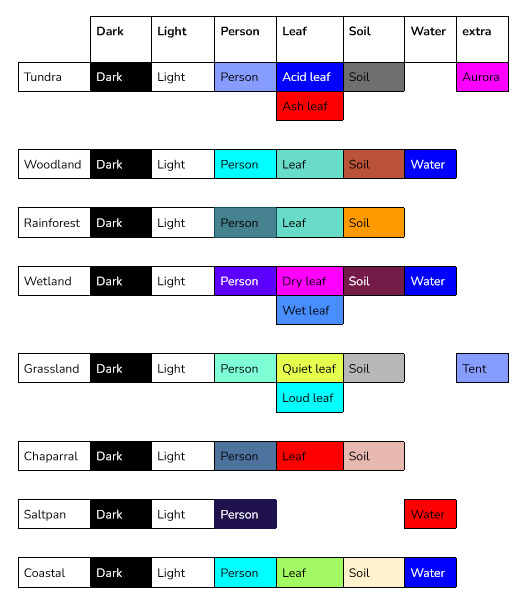
507 notes
·
View notes
Text

“Remember the earth whose skin you are: red earth, black earth, yellow earth, white earth brown earth, we are earth. Remember the plants, trees, animal life who all have their tribes, their families, their histories, too. Talk to them, listen to them. They are alive poems.” - Joy Harjo, Native American Poet Laureate
Getting in Earth Day art just under the wire! The five dancers represent the five main biomes of Earth: Tundra, Aquatic, Desert, Grassland, & Forest. My hope was to demonstrate the power and fragility of each environment as they balance precariously against each other—or perhaps *alongside* each other. Either way, we’re all part of the dance. 🌎❤️
Time-lapse video under the cut!
61 notes
·
View notes
Text
Earth 101 : A Manual for the Visiting Cybertronian
Chapter One : Planet Earth
Planet Earth is located within the aptly named ‘Milky Way’ galaxy, as the humans liken the hazy starlight to ‘spilled milk’ [ See: Earth Fuel/Foods ,Earth Phrases for more information ]. A young star system in comparison to Cybertron, the planet of Earth is located in what the humans rather creatively called the Solar system, as their measurements of time are based on the rotations their planet takes around the center of their system, a star they call the Sun.
They appear to regard it as one of the main factors for life capabilities on Earth.
Earth is the 3rd planet from this Sun, and is in what humans call the 'Goldilocks Zone' [See: Earth Fables and Folklore for 'Goldilocks' definition.] , resulting in its capabilities for sustaining life.
Earth has only one moon orbiting itself, and is not a large planet, but still one of impressive accomplishments, being the only planetary body in its system which hosts any form of life at all.
Earth is a planet rich in water, as an impressive 71% of the planet is covered in dihydrogen monoxide, also known as H20, or commonly referred to by the native humans as water.
Astoundingly however, the majority of this water is not able to be used by the population as sustanence due to the large part of their seas being salt water, which in large quantities is harmful to the populace.
The Earth is divided into several continents, which they populate, save for a handful which are so cold that no human in their right mind would inhabit.
Editor’s Note: It appears this information was flawed, as human scientists have in fact resided in the Arctic and Antarctic on months long expeditions in sometimes sub zero temperatures that would be harmful if not for their fortified shelters in these cold enviroments. Why they would do this remains wholly confusing to our own kind, as such temperatures are deadly if exposed for too long.
Within these continents, various countries exist, which are populated by various organic beings, but the majority being human cities or colonies which vary in levels of technology and density of population.
Most impressive about Earth is the biodiversity, as its entire planet houses various forms of weather and ecosystems.
Earth can go through various types of ecosystems, ranging from calm forests, scorching deserts, freezing tundras, lush rainforests and jungles, and even entire cavern systems below ground, and amazingly, there is a report of an entire cavern in a secluded area of the planet, which created its own weather system of a sort. A fascinating show of how wondrous this planet can be.
Our Maximal and Eukarian natives have often stated that the various biomes of Earth remind them of their own home worlds and other planets that they had visited eons ago, which has offered a comforting reminder for some.
Terran flora can come in a great and numerous variations.
Flowers who grow and blossom for a mere few hours, and trees whose height far surpasses that of any regular Cybertronian, and could rival that of Combiners or a smaller classed Titan. Terran flora can also be quite vicious, as there are many a poisonous plant that exist and can harm humans if used incorrectly in medicinal and even casual usage such as cooking.
When asked how humans determined which plants were safe to eat and which were not, the method of 'trial and error' was the most recognized, despite the fact this meant the possibility of grievous harm to their health.
It is truly a miracle how humans survive such a deadly and dangerous planet so easily and calmly, though human media suggests they are quite heroic in survival matters.
Editor’s Note: I have been informed that the 'heroic propaganda' cited above is what is known as action movies, a common pastime and entertainment form on Earth. Apologies for this error.
Equally impressive however is the existence of flora who in fact hunt, consuming insects rather than photosynthesizing for survival. The plants are small but it would appear that some can capture quite large [for human standards] bugs or even small animals if they are the correct size.
That said, though we are of great stature in comparison to Terran fauna, please do not feel inclined to challenge the native wildlife.
Many a Cybertronian medic has had to repair dented frames from foolish mechs and femmes alike who did the following :
Gave chase to predator species in an attempt to scare them off. Result : Scratch marks and punctures of claws
Fought undersea wildlife, primarily sharks who in self preservation tactics, would bite and leave teeth imprints and even teeth themselves on a mech's plating.
Said undersea incident also resulted in the tangling of seaweed and kelp within said bot's joints.
Bots who attempted to befriend wildlife instead would also be met with hostile reactions at times. This is a reminder that a real wild bear is not the equivalent of the toy known as the 'Teddy Bear'. Real bears will attack you.
There are animals who have tusks and horns as defensive features to their bodies. These will dent and at worst, puncture your plating or even through your frame.
Do not attempt to pet the bison/buffalo. They look friendly. They are not.
No, predatory species known as the 'big cats' are not in fact like regular domesticated household pet cats. They are not friendly.
Wolves are also not the same as household dogs. Approach with caution. Or don't. Please.
Birds of many varieties like to collect 'shinies'. We apologize to those who are stationed in the continent of Australia, as the species known as magpies are particularly vicious.
Reinforced plating is advised for those visiting the particularly wild nation of Australia. All Australian wildlife in general appears to be particularly deadly in some capacity.
Though small in size, bugs will splatter on windshields in your vehicular form. No, it cannot be prevented. We advise regular trips to the human creation known as a 'car wash'.
Rather interestingly as well, Earth’s native flora and fauna sometimes resembles Cybertron’s very own, just in organic manner. This could be due to the fact that centuries ago, Earth was one of the many worlds which Energon hoards were stashed till the planet itself began to grow its very own after the prolonged exposure.
Editor’s Note: Things have been revealed that this editor will simply say…they explain a lot more now.
A LOT more.
To be explained perhaps in another section of this field guide/manual to your cohabitation on Earth.
However, Earth does very clearly differ still from our own home, as it is as stated before, organic in nature, and its iron, steel and other metals are found deep within the Earth, not like on our world where they’re so clearly topside in comparison. Earth manufactures its metals, wiring, and other technological components, which are otherwise not found naturally.
Earth also, despite having Energon, doesn't use it as a fuel source, instead it will use oil, most commonly petrol, electrical currents and in some bizarre cases, even use nuclear power to power various forms of human settlements.
Editor's Note: As it seems, humanity is actually unaware of what Energon is despite the planet being quite rich in its deposits.
They appear to not have the technology to even detect it, deeming it as, in the words of one of our allies 'Just another pretty thing to look at'. Absurd by our standards, but we do not judge for their inability to comprehend the importance of it.
Despite this, Earth has been trying for roughly a vorn, to transition to alternative power sources, such as solar power, kinetic energy like that of the air with their windmill turbines, and even using organic matter of various kinds to attempt to form alternative fuels.
These endeavors are well documented and admirable, as their main source of fuels, aptly named fossil fuels, are in fact, the liquidized form of the planet’s previous inhabitants known as 'Dinosaurs' ,which went extinct many many centi-vorns ago.
[See: Cybertronian-Earth interconnections : Dinobots for more details. ]
This concludes the introduction to the basics of the planet Earth’s status.
Any and all queries related to further information of the Earth’s composition, atmosphere, and otherwise related geographical information, please direct them to the author appropriately so that your query, dear reader, is properly answered with dutiful knowledge and understanding, to help your fellow Cybertronian!
#transformers#transformers prime#tfp#tf prime#maccadam#maccadams#earth 101 : a manual for the visiting cybertronian#nova writings#nova notes
127 notes
·
View notes
Text
Reyal At A Glance - Climate

Map by @nexelart (twit)
Reyal - A World of Extremes
As per the previous post stated, Reyal is much like our own Earth in terms of biodiversity, as well as a few other traits. In this post, we'll explore Reyal's weather and biosphere a bit more!
Reyal's climate has shifted greatly during it's history. From the early start of life, it was a much hotter world; it's atmosphere used to contain much higher amounts of carbon dioxide and other greenhouse gasses, making it a much more tropical world than it is today.
Nowadays, Reyal experiences a much colder climate than Earth, as it lost much of it's greenhouse gasses during its several billion year long evolution. On top of this, Reyal orbits a bit further out from Tenav's habitable zone than we do around our own Sol.
At the poles, including wind chill, temperatures drop down to -103c on average at the surface. At the equator, the highest you can expect is a balmy 27c. Weather can of course influence these temperatures, but thanks to Reyal's lack of seasons and relative climatic stability, these tend to be year-round temperatures.
Thanks to it's colder climate, most of the planet is dominated by humid continental biomes, as well taiga and tundra. Due to a lack of water compared to Earth, most of the equator tends to be dominated by savanna and desert, with only a few key areas near the equator bearing rainforests.
Life has taken a massive advantage of this stability, and as such, Reyal can be very well described as a garden planet. Flowers and fruiting plants tend to grow very rapidly, leading to an abundance of food and other biological resources.
This all works out perfectly for the Lyratet, however, as they have evolved to be more adapted to colder climates. Due to their thick fur, habitation near or on the equator is near impossible, lest they suffer from the effects of overheating. Only a few settlements exist in the equator, and are primarily underground. Despite the heat, some do inhabit the surface briefly during the night or Tenavset/rise.

Edit of @nexelart's map, showing the equator and northernmost/southernmost parts of the poles greyed out
As seen in the image above, this excludes a fairly large part of Reyal for habitation. Most of the equator is designated as a ecological reserve then, with very little being known about it. Scientists do mount expeditions to document flora and fauna, but more often than not, the region is left to itself.
This lack of habitability at the equator has greatly affected Lyratet history. For almost the entirety of the two hundred thousand years that they have first had cultures, they had no real means of accessing the northern hemisphere. As such, they were relegated to the south, and struggled to develop for much of their history. In what would be 1113 A.D. our calendar, two brave souls finally took it upon themselves to transfer through the mountain ranges that intersect with the Great Desert Rings, and set foot up north. This is a story for another time, though!
In the next post, we'll be exploring the origin land of the Lyratet; the Land of Tenav's Dawn.
Directory: Intro | Climate | the Land of Tenav's Dawn | the Desert Rings | Therikine | the Great Central Desert Mountains | the North Glacial Plains | the Yuniv-Semat Basin | Juleg Marrdev Technocracy | Yuniv-Semat Trail | Ro | Velgae
#my posts#reyal#reyal at a glance#worldbuilding#creative writing#writeblr#speculative evolution#spec evo#sophonts#aliens#as we go along#awga
33 notes
·
View notes
Text


LABRADOR TEA || retain old leaves rather than drop them
0 notes
Text
Despite the general cooling of the planet one particular continent is starting to warm up, allowing a more varied climate better suited for both plant and animal life.
Antarctica has been fully covered in ice for the last 30 million years, but now thanks to its movement northwards and the formation of the Magellan islands between the Antarctic Peninsula and Tierra del Fuego the flow of the Antarctic Circumpolar Current has been broken, allowing warm currents to go along the Pacific coast.
The dominant biome here is tundra and cold prairies, broken by rivers and wetlands.
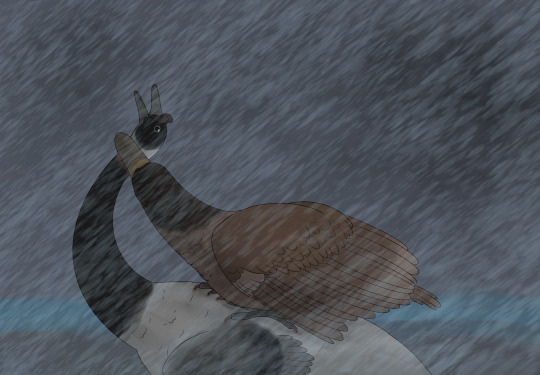
The largest animals here are all birds. The most common herbivores are flightless ducks and other anseriforms, that get preyed upon by large, but still well adapted for flight, terrestrial birds. These peregrine falcon descendants (Gyrornis ambulans) have developed a hunting strategy much different from that of its ancestor, now basically pouncing on their prey, aided by their wings, and crushing their windpipes with a bite to the neck, in a similar fashion to cats. Although specialised for larger prey they’re also able to take smaller game, allowing it to spread into South America where it feeds on small rodents, youngs of bigger animals and birds.

An unlikely inhabitant of these grasslands is a flightless bird, similar to an upright kiwi that feeds on insects and eggs. Unlike any other bird in the area, its posture, almost plantigrade feet and flattened wings show his ancestry. It’s a penguit (Erectopteryx palmeri), a descendant of small penguins that exploited the new Antarctic environments early on, becoming a quite successful generalist.

The richest ecosystem on the continent are the cold wetlands brought forth by the melting glaciers. These immense areas are a biodiversity hotspot where a myriad of aquatic and semiaquatic species live. At the base of the food chain there’s many freshwater fish lineages, in this case cichlids, trouts and salmons, and semiaquatic insects, like dragonflies and mayflies, that got here from South America. The biggest river predator is the garlachea (Garlachea antarctica), a large salmonid similar to the Amazonian arapaima or to sturgeons. It shares the environment with many semiaquatic mammals, like the English otter (Pyrolutra anglolittoralis), many aquatic rodents, and one of the biggest monotremes yet, the giant polar platypus (Neopilopus fluvialis) that bottom feeds and occasionally catches small fish and other vertebrates.
The swarms of insects feed many more animals, attracting flocks of bats and birds, and feeding the ground dwelling flightless bats and semi-terrestrial salmonids.
#spec evo#spec bio#speculative evolution#speculative biology#worldbuilding#artwork#digital art#epigene period#future earth#future evolution
19 notes
·
View notes
Text
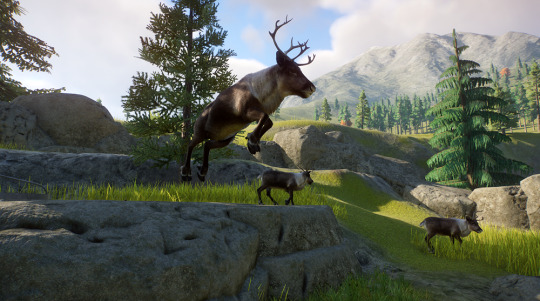
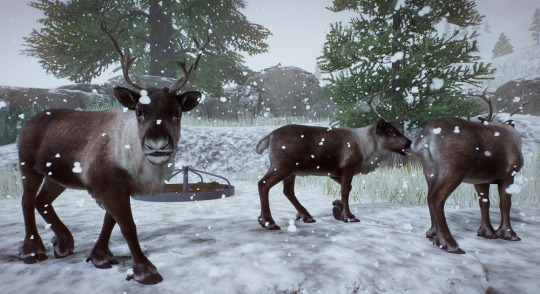
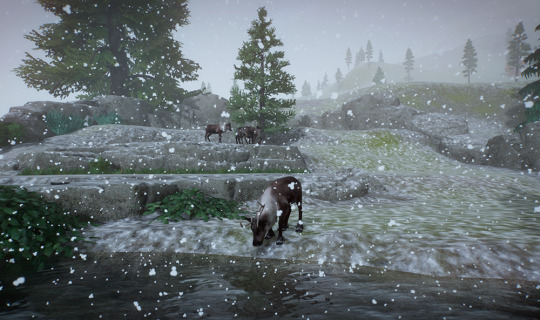


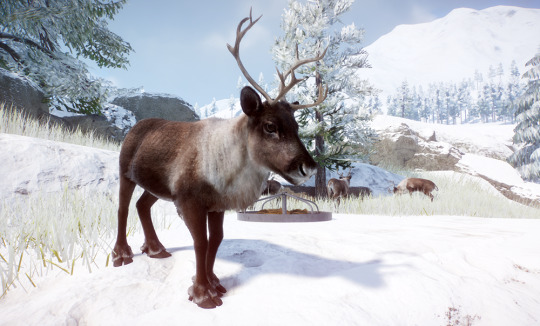
Because I can, have some pictures of ladies in the snow.
Lady reindeer, that is. In Planet Zoo.
I started a new franchise-mode game. My plan is to eventually have three smallish zoos in the franchise -- one tropical, one desert/grassland, and this one, which is in a taiga biome and will have taiga, tundra, and temperate animals. Across the franchise, I want to focus on breeding high-quality endangered/critically-endangered/extinct-in-the-wild animals to release to the wild, and I want to have all of them living in environments that are as natural-looking as possible, keeping visible habitat barriers to a minimum and not focusing so much on stuff for guests beyond the basics to keep them somewhat happy in order to keep money coming in. To the extent possible, I also want to build very large habitats with multiple species living in them, both for naturalism purposes as well as for interspecies enrichment bonuses.
So do you see any habitat barriers in these pictures? No. No, you do not. They are there, though. Especially because this habitat isn't close to finished yet, so one side of it will have ugly barriers until I build the hard shelter that I need to build for my ladies here. It also needs a lot more terrain painting and plantings and stuff. But, I'm quite proud of the terrain sculpting so far as well as how I've concealed the barriers in ways that blend in with the surroundings.
And no, reindeer aren't endangered, but since I'm just starting out, I don't yet have the resources to buy the kinds of animals I ultimately want to breed. I managed to find my ladies here in the online market, and they have decent appeal to bring in guests money. They each have decent-to-good genes, so once a decent-to-good male shows up in the market, they can start making with the babies. Eventually, the herd of reindeer will move to a multispecies habitat, where they will live with a herd of Przewalski's horses, a herd of takins, and some Bactrian camels, and this habitat will be taken over by a pack of timber wolves.
I do have a male red panda that I managed to catch in the market for an affordable price waiting in quarantine, and red pandas are actually endangered. And also incredibly adorable. But, he'll be staying in quarantine until I finish the reindeers' temporary habitat and let some cash build up. And then I'll keep my fingers crossed and hopefully find a female red panda with decent fertility for a price I can afford. That's half the difficulty of franchise mode, really, especially if you want the more endangered animals.
Anyway, yeah, if you don't see me for a while this'll be why. LOL Maybe I'll share some more pics as I go, though. Because I can.
#non sims#planet zoo#i also picked reindeer because I like them#i think they're really pretty#and I like that the females have antlers too
32 notes
·
View notes
Text
Some Ecology Vocabulary

for your next poem/story
Autotroph - Any organism that is able to manufacture its own food; derive energy from inorganic sources (light or inorganic chemical reactions)
Benthic - Organisms that live on the bottom of the ocean
Biome - A community of plants & animals that occupy a distinct region; defined by climate and dominant vegetation: tundra, desert, grassland & forest; can be subdivided, i.e. boreal, temperate, tropical forests
Boreal forest - (also called Taiga) Largest terrestrial biome, characterized by having very cold winters and coniferous forests
Dessication - Mummification
Detritus - Accumulated organic debris from dead organisms
Detrivore - Any organism which obtains most of its nutrients from the detritus in an ecosystem
Disturbance - An event that alters the ecosystem, i.e. the plant community and possibly the physical environment; natural disturbances include fire, landslides, windthrow, insects, disease, etc. Levels of Disturbance:
Tree-level: affects single trees or small groups of trees
Stand-level: affecting large groups (many hectares) of trees (insect epidemic, hurricane, logging, wildfire)
Site-level: affecting the physical environment is a dramatic way that all life is lost and a new soil environment is created (lavaflow, glacier, landslide)
Planet-level: affecting the planet as a whole (big meteor, death star...)
Frugivore - Animal which primarily eats fruit
Groundwater - Water found underground as a result of rainfall, ice and snow melt, submerged rivers, lakes, and springs. This water often carries minerals. These minerals can accumulate in the remains of buried organisms and eventually cause fossilization.
Halophile - Organism which lives in areas of high salt concentration. These organisms must have special adaptations to permit them to survive under these conditions.
Limnology - The study of river system ecology and life
Orographic Lift - Occurs when an air mass moves over a mountain range, air cools, drops precipitation, then as air moves down the lee side it warms and creates a rain shadow
Pelagic - Organisms that swim through the ocean, and may rise to the surface, or sink to the bottom
Rain shadow - The dry region on the leeward side of a mountain range, where rainfall is noticeably less than on the windward side
Riparian - Having to do with the edges of streams or rivers
Saprophyte - Organism which feeds on dead and decaying organisms, allowing the nutrients to be recycled into the ecosystem. Fungi and bacteria are two groups with many important saprophytes.
Silvics - The study of the life history, characteristics and ecology of forest trees
Tolerance - The capacity/ability of an organism to endure (survive, withstand) adverse effects from unfavourable environmental conditions; the opposite of sensitivity
Upwelling - The raising of benthic nutrients to the surface waters. This occurs in regions where the flow of water brings currents of differing temperatures together, and increases productivity of the ecosystem.
Xeric - Describes an environment or habitat with little moisture; dry to very dry
Sources: 1 2 ⚜ More: Word Lists
#ecology#terminology#word list#science#writing reference#dark academia#studyblr#langblr#writeblr#spilled ink#light academia#literature#writers on tumblr#writing prompt#poetry#poets on tumblr#writing inspiration#writing inspo#writing ideas#creative writing#john frederick lewis#writing resources
75 notes
·
View notes
Text
❅MCU Jotun Headcanons❅
in honor of @jotun-design-party by magpiemurder. I had been looking forward to this contest for several months, but i have not been able to do anything for it and i doubt i will magically be able to do something and submit it by the time the deadline roles around (which is in like less than a week). This makes me sad, especially since i was something i was actually looking forward to participating in (and for such a long time) :(.
but anyways. headcanons instead, i suppose:
(also these are not very organized so have fun with that)
while jotuns do have extremly low body temperatures, the "frost-bite" affect you see them inflict in Thor 2011 is not because of that. Instead, it is due to a residue on their skin (like poison dart frogs).
Unlike poison dart frogs, however, the residue doesn't just stay on their skin 24/7. Rather, it secretes out of their pores
When jotuns are young, it secretes automatically when they feel scared/threatened (or exhibit other strong emotions), but as they get older they learn how to control it and can do it on command (and also keep it from happening). (<- my reasoning for why loki's cloths froze and chipped away the first time but not the second)(sort of)
the blocky/chunky/heavy type architecture you see is because it is sturdy and can survive blizzards/other harsh elements
based off of what odin said in his monologue, jotunheim is "cold dark and barren," so the next few sort of are in line with that, but who know if he was actually telling the truth lol
not a lot of biodiversity (and FAR less plants than animals) :/ (i actually think it'd be cool to have a frozen planet teeming with life, but again, prev reason...)
since it's hard for plants to grow in such cold/dark places (lack of sun, dirt/nurtients, nutrient flow, liquid water, etc), the only "normal" plants you see are in the north pole (which is warmer, and is sort of a tundra type biome)(most plants typically aren't even there year-round). Everywhere else, plants have to find other ways to survive. Since photosynthesis isn't really a viable option (though there are a rare few that do!), most plants either perform chemosynthesis (x) or are parasitic (x). This also means that lots of plants are a ghostly white, rather than green (no chlorophyll).
licehen is less common than here, but can be found on occasion (and can be eaten)
mushrooms are relatively common, however (and unlike our mushrooms, can survive alright in the cold)
There isn't really any liquid water (and what little is seasonal), yet there are still life in the frozen water. There is a species of fish that produces so much warmth that the ice around them melts, and they swim through their self-made streams (that freeze back up once they've left). These fish eat snow/ice algae and ice worms (the algae and worms are actually real things in real life btw) (x) (x)
I thought it was interesting in the film how it's such a cold planet but nothing seemed to have fur, just skin... perhaps there are furred creatures, though, and they simply live in other regions. Id say the south pole, maybe the north pole, and and/or an isolated bit of land ("continent") on the opposite side of the planet. Long wooly fur. Horns. These creatures evolved to be warm on the cold, and the creatures we saw in the film simply evolved to not need to be warm at all.
the clothing you see the jotnar wear in the Thor 2011 is not their usual wear, it is their wartime/battle clothing.
This is because even though they are no longer literally warring, odin's treaty (aka sentence to slow genocide) was a "war against their people." As such, the majority of the jotnar choose to wear the wartime clothing until they all die out (as sort of a statement against odin/asgard's colonialism/imperialism)
(also probably "honor" or other culture type situation)
War clothing components:
Shaved Head: The jotnar typically grow their hair out long in times of peace, but shave it when times of war arise. In some regions, it is only those that go to battle that shave it, but in other regions all people shave it
Loincloth: made from Frost Beast leather. While frost beast hide is blue, the process to turn it into leather gives it a green tone (and is also becomes more rubbery than our leather). The sewing pattern of the loincloth itself typically is what gives it creative design, rather than having added embroidery/beading/embossing/etc.
Misc Decorations:
small decorative pieces are stuck directly to the skin via freezing water or using sticky sap-like substances. The most common places for these decorations are the head, upper chest, and shoulders. These pieces serve no protective functions, save the ones that are used to cover the nipples of jotuns with breasts (just around the nipple and areola, not the full breast).
small bracers, pauldrons, and greaves are sometimes worn.
Never shoes, pants/bottoms, shirts/tops.
Clothing should be NON besides the loincloth, and armour should be minimal and mainly decorative.
Decorative pieces are typically also made of frost beast leather. Metal is not usually used on jotunheim, because it is far to cold to melt anything (and to actually start a fire that hot would cause massive environmental damage). The only metal typically used it mercury, because it has such a low melting point (-38.829° C/-37.892° F). Interestingly, leather and mercury (and ice) are the only materials used in war clothing, not bone, even though bone is used in non-wartime clothing.
Overall Scarcity of clothing: While the jotnar don't typically get cold, they do want protection from cutting winds, ice, and snow (blizzards are strong enough that the snow can cause cuts/"burns"). As such, having such scarcity of clothing is a statement of strength/bravery and used to deter the enemy.
regular cloths cover more (to protect from the elements, not provide warmth). Leather, metal, fur, and fabric woven from wool are used. Bone and metal are also used. Typical colours would be the familiar green, dusty purple, grey/brown/black/white (fur colours), and some blue
piercings and gauging are popular, even though not always practical. Most popular places to pierce/gauge are the ears and nose.
Hair texture in the region where we visited in thor 2011 is typically smooth and silky (like lokis), but other hair textures (curly, coily) exist in different areas. All hair is typically raven-black, unless the jotun is albino (in which case, it would be white)
Unsure of:
i feel like jotuns would be carnivores, but at the same time i feel like loki would enjoy more vegetarian/pescatarian food options, so idk what to think :|
I feel like the casket of ancient winters would be taken straight from the core of the planet, and is super condensed ice and seiðr, and that's why taking it away ruined the planet
(but then that poses other questions, like why would they mine something and keep it as an artifact? were there warring tribes and they wanted to get ahead? did some foreign colonial/imperial power mine it and for their own gain and the jotuns only got it back later?)
also the other possibility is that the casket has to do with something of the passing of ancestors/powerful jotuns of the past and their seiðr or souls or smth is in it (and that would give more power to the "casket" part)
i actually i can think of a lot of things... but those are my main two for the casket
wait why are my indented bullet points not working anymore what!!! this was more neat-looking i swear
jotun breast milk does not have lactose. i will not elaborate.
ok those are all i can think of right now
(bonus loki-specific one: the reason he is so small was because his mom got stuck by lightning when she was pregnant)
#seriously tho i'm sad about the contest :(#:(((#unityrain.txt#mcu jotunheim#jotunheim#jotun#jotnar#jotun loki#mcu loki#loki#worldbuilding#mcu asgard#headcanon#headcanons#long post
26 notes
·
View notes